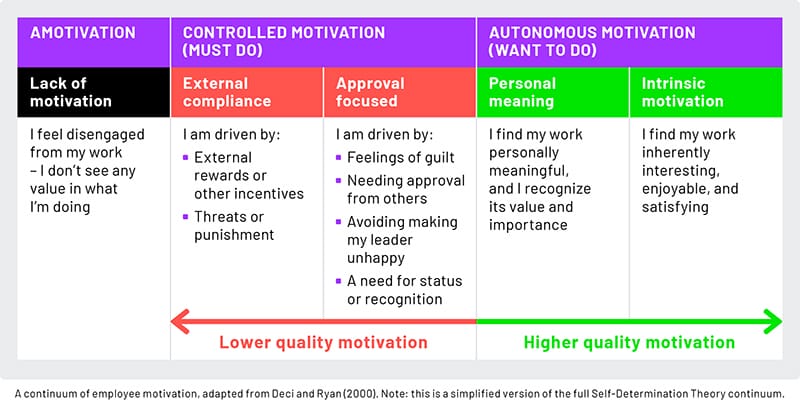Written by Dan Hughes, Director of International R&D
Leaders in today’s world of work are facing a rapid pace of change involving complex and unpredictable challenges. Digital disruptions such as generative AI and other advanced technologies are changing the playing field for many organizations. This certainly doesn’t make things easy for leaders who need to find ways to energize their teams to navigate these challenges with agility and creativity.
So, how can leaders best do this and set their organizations up for sustainable success? One answer is intrinsic motivation. Understanding intrinsic motivation and how to build it lies in having a deeper understanding of the science of motivation and shifting the focus towards more human-centered leadership – a core theme that emerged from our international research study regarding the future of leadership. Leading through change effectively requires leaders to foster the intrinsic motivation and drive that comes from within employees, rather than relying on extrinsic rewards, incentives, threats, or punishment.
Understanding different types of motivation
Extensive research into the psychology of motivation shows that employees experience different types of motivation at work. These types of motivation exist on a quality continuum shown below. It is worth noting that at different times and in relation to different work activities and goals, it is common for people to move between various points on this motivation continuum.

At the lower end of motivational quality are various levels of controlled motivation, where people feel they must perform an activity or deliver a goal because of extrinsic factors. They could feel compelled to comply because of tangible rewards being offered, such as pay and incentives, or threats or punishments. It might also be partially internalized, where employees feel pressure to achieve goals because they want to gain approval or avoid disapproval from their leader or colleagues.
In contrast, high quality, autonomous motivation is characterized by people feeling a sense of choice and embracing goals because they find them personally meaningful and aligned to their values. At the very top end of this motivation continuum is intrinsic motivation.
What is intrinsic motivation?
Intrinsic motivation is an innate desire we feel to complete a task because we find it interesting or enjoyable. It’s a point where we are fully engaged and absorbed in an activity because we like doing it, not out of any sort of obligation to perform. Understanding intrinsic motivation in the workplace is important because it fuels employees’ passion, satisfaction, and commitment, leading to higher productivity and creativity.
Why should leaders care about intrinsic motivation?
Intrinsic motivation is important for leaders to understand because decades of research studies indicate that more autonomous, intrinsically motivated employees tend to demonstrate greater job performance and productivity. They are often more persistent, focused, and engaged in their work. Moreover, employees fueled by intrinsic motivators tend to deal with change better, show more initiative and innovative behavior, and feel greater commitment to the organization.
On a personal level, intrinsically motivated employees also report experiencing greater well-being and happiness with lower levels of burnout. So, if leaders create a climate that supports intrinsic needs, the result should lead to both productive and happy workers – the ideal mix.
This is not to say that rewards and incentives don’t have their place at work – of course they do. However, leaders should recognize these are not the motivators needed to build high quality intrinsic motivation within their teams. In certain situations, emphasizing external rewards, or extrinsic motivators, can even have a negative impact as they can narrow someone’s focus, reduce creativity, and encourage more counter-productive behaviors at work, such as a lack of collaboration.
What do employees need to become more intrinsically motivated?
Intrinsic motivation is fueled by three basic psychological needs that everyone shares. These are:
- Autonomy – The need to feel a sense of choice, ownership, and control of your own actions
- Competence – The need to be effective in your role and develop new skills and expertise
- Relatedness – The need to have positive relationships and feel a valued part of the team
For humans, these needs are just like how plants need sunlight, water, and nutrients from their soil in order to grow. They are the ingredients that people need to flourish and thrive. When these psychological needs are fulfilled at work, employees will be more intrinsically motivated, perform better, and feel happier.
The power of leadership in fueling intrinsic motivation
At work, leaders can make a dramatic difference to the employee experience (potentially the biggest difference of all) by facilitating intrinsic motivation. Research across a multitude of studies shows that positive leadership styles are associated with higher intrinsic motivation, while toxic leadership has the opposite effect.
Intrinsic leadership is all about leading from within – drawing on personal motivation, values, and a strong commitment to principles. Leaders should therefore pay close attention to the intrinsic needs of their employees and how they can best support them, especially when the working context is continually shifting at a rapid pace. When leaders are able to focus effectively on facilitating these employee needs, it can boost employee engagement, spark innovation, and create a sense of shared purpose within a team.
How to use intrinsic motivation as leaders
Here are some practical steps leaders can take to fulfill employees’ basic psychological needs and build intrinsic motivation, particularly when leading people through change:
Build autonomy
- Provide an inspiring purpose and vision for change which aligns to employee values and gives them a sense of meaning.
- Reduce the sense of change being ‘done to them’ by involving employees as much as possible in discussions about how to respond to change. If people understand the reasons for change, they are more likely to embrace it.
- Consult employees across the different stages of a change process by asking them for their feedback and input into plans and logistics for change.
- Empower employees by giving them clear ownership and choice in how changes are best implemented in relation to their own roles.
Build competence
- Provide clarity about objectives and performance expectations so employees can better understand what they need to do to make the change process successful.
- Support employees by offering coaching and training in how to adapt to new ways of working. People can be anxious about the unknown, so providing support and reskilling can help.
- Look for stretch opportunities where you can give individuals challenging but achievable tasks which will help them develop.
- Give employees prompt and constructive feedback about what is working and not working so they know exactly how to improve.
Build relatedness
- Emphasize to individuals the role they can personally play in helping to drive change.
- Ask people how they feel about new ways of working and genuinely acknowledge any concerns that they share with you. Keep in mind change is often uncomfortable.
- Be inclusive in your approach – consciously find ways to involve everybody and ensure you hear from a variety of different perspectives.
- Check in regularly with people during the change process and show concern for people’s well-being.
Empower organizational success through intrinsic motivation
To effectively navigate the workplace, leaders must foster intrinsically motivated and engaged employees. This means adopting a people-centered leadership approach rooted in the science of employees’ core psychological needs. By prioritizing intrinsic motivation and addressing these fundamental needs, leaders can create a work environment where individuals feel naturally driven, committed, and enthusiastic about contributing to the organization’s achievements.




